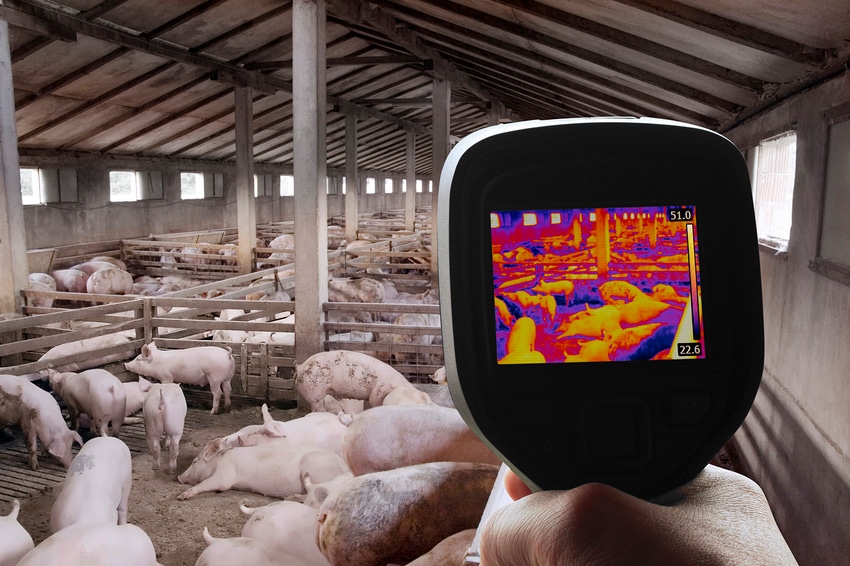Four disruptive technologies that will drive animal ag forward
Hostetler says the industry may soon be using “cough monitors,” facial recognition technology and Bluetooth sow ear tags.

When it comes to livestock production, technology isn’t going away anytime soon, says Chris Hostetler, the director of animal science for the National Pork Board, and we don’t need to be afraid of it.
“I think disruption represents the opportunity for making improvements in the way we raise livestock and addressing challenges to animal welfare and health. There is also substantial opportunity for additional business by interacting with non-traditional business partners,” Hostetler says. “There is no question, technology is here to stay.”
During Alltech’s ONE Ideas Forum this week, Hostetler shared four disruptive technologies that will drive animal agriculture forward, once they are properly regulated and consumers accept them.
1. Precision genetics — Breeding for deliverables
Gene editing can convey resistance to porcine reproductive and respiratory syndrome, a disease that affects approximately 10% of the herds annually at a cost of around $640 million annually to the U.S. swine industry. Through CRISPR technology, the receptor for the virus is removed so the gene-edited pigs do not get sick. But questions still arise whether the product is safe and who is supposed to regulate it?
The USDA regulates gene-edited plants, however gene editing on the animal side currently falls under the regulation of the Food and Drug Administration, and the FDA is currently calling the technology a drug.
“They say every time you breed two gene-edited animals together, the resulting offspring is a drug and you have to prove that drug is safe,” Hostetler says. “That costs about $20 million to do that.”
After the industry works out how to regulate gene-edited animals, the next challenge will be getting those genetics spread through the system.
“Every time you want to convey a new gene edit, that will convey some sort of beneficial trait to the animal in terms of welfare, health or productivity, genetic companies will need to spread those genes down throughout the system,” Hostetler says. “It will take a long time to get them spread throughout, so the commercial pork producer can have pigs resistant to those diseases.”
Consumer acceptance will be the next test to pass regarding gene editing, as Hostetler says we can’t move forward without that social license.
“People don’t understand what GMOs are and we certainly don’t want to go down the same path as GMOs with gene editing,” Hostetler says.
Hostetler encourages producers to get in front of the discussion and visit sites such as The Center for Food Integrity for talking points on the matter. After all, Hostetler says gene editing holds great promise for animal agriculture. On the human side, there are already some cancers that can be gene edited. On the animal side, Hostetler says the first gene edits will need to exhibit a health benefit or animal welfare benefit.
Finally, after getting regulation and social licenses passed for making improvements in welfare and health, gene editing could be used to improve productivity of the animal to address issues such as nutrient utilization, gut health and gut integrity.
“Why is that last on the list? As a producer, that should be the first thing we do,” Hostetler says. “Consumers often think farmers should farm out of the goodness of their heart, that farming should not be a business proposition, and doesn’t want to see profitability be the bottom line for decisions made, so that’s why the other three must come first.”
2. Cultured “meat”
What to call it is the first question we need to ask. Even though it does come from animal cells, Hostetler questions do we call it “meat?” Also, can we learn something from the dairy industry? The market has become flooded with almond milk, soy milk and other plant-based milks that are not as nutritious. The meat industry can learn from that experience, Hostetler says.
While the pork industry has been monitoring this area, the beef industry is really taking the lead. In fact, Missouri has already passed legislation where “meat” cannot be used on these product labels.
But Hostetler questions is cultured “meat” a bad thing? Or is it an opportunity for the industry? For example, some traditional protein companies are investing in it. For them this may represent an opportunity to participate with non-traditional companies as this technology is developed.
“For a monetary investment, they get to find out what the other companies are doing, they get access to all the data, all the graphs and technologies that are being developed, and they also get the opportunity to help in the development of that technology so it’s very important from a business continuity standpoint,” Hostetler says.
While venture capital is flowing into this sector, Hostetler suggests this type of technology may be a way to address getting food into food insecure areas and a way to help tackle malnutrition in those areas.
“We need to think beyond the borders of the Midwest and think about these technologies in terms of opportunity,” Hostetler says.
3. Big data — Knowing what your data knows
Hostetler says while big data is largely driven by the crop sector, there is much potential for it in animal agriculture. However, as livestock production uses big data we will need to determine who owns the data, has access to the data and where it will be stored.
For example, IBM-Watson owns the platform where all the weather station data across the globe is uploaded. That data is so big they cannot move that data and if someone wants to interact with that data, they have to move their data over to the IBM-Watson platform to interact with it. Hostetler says animal agriculture will need to keep those issues in mind when it comes to big data. Accessibility, good versus bad data, analytics and algorithms will all come into play.
“Through big data analytics, we think we can do some predictive analytics,” Hostetler says. “We can say ‘see that sow walking down the aisle? there’s a 65% chance she is going to be lame next time she comes out of the farrowing house, you should cull her now and get some cull value out of her.’ So, using predictive analytics we can garner some of that revenue we would have otherwise lost.”
4. Monitoring — Observing what’s important
Monitoring is again being led by the crop side, but the technology isn’t far away from disrupting the livestock side as well. The goal would be to monitor not only groups of animals but also individuals within groups of animals. Hostetler says that’s a big challenge but one that can be done.
“If we simply translate field to pen, plant to animal, then the crop side and the livestock side are talking the same language,” Hostetler says. “We are concerned about the same things. We are concerned about resource utilization on the plant side, we are also concerned about resource utilization on the animal side.”
Hostetler gives the example of how a pig farmer today knows when to treat the barn for a cough and how that can be much more precise with monitoring technology. By placing “cough monitors” in the barn, when the pigs start to cough, the producer will be able to quickly and easily identify where that cough is coming from and treat those individual animals.
“So instead of treating the entire barn, sort of prophylactically and retrospectively, we can now be proactive in our antibiotic utilization,” Hostetler says. “It’s a much more strategic plan for utilizing antibiotics.”
Another example Hostetler says is incorporating Bluetooth technology in a sow ear tags. The producer wouldn’t need to read the number on each ear tag but could use his or her phone to find individual sows.
Facial recognition technology could also benefit swine producers, Hostetler says.
“What if we could put facial recognition technology right above the waterers for the pigs and every time a pig steps up to the waterer to take a drink, it measures the distance between the pupils of their eyes. As a pig grows, the distance between their pupils increases and based on an algorithm, it can calculate its weight gain in real time,” Hostetler says. “Who wouldn’t want to be able to do that?”
Hostetler says this technology could also be useful when it comes to water utilization by recognizing those pigs in the pen that are habitual water wasters. When those pigs come up to drink, water would only be released for a short period of time, so less water would be wasted. This conserves a critical resource.
Finally, Hostetler says some of this monitoring technology could help the industry make better decisions than labor can and instead use that labor in a more efficient way.
“We do have a need for skilled labor in our animal facilities and we just don’t have that available to us at this point,” Hostetler says.
Hostetler says while all of these technologies are certain to bring disruption to the livestock sector, they should not be viewed negatively. They should be embraced for they represent opportunity to improve animal health, welfare and productivity.
About the Author(s)
You May Also Like


.png?width=300&auto=webp&quality=80&disable=upscale)


